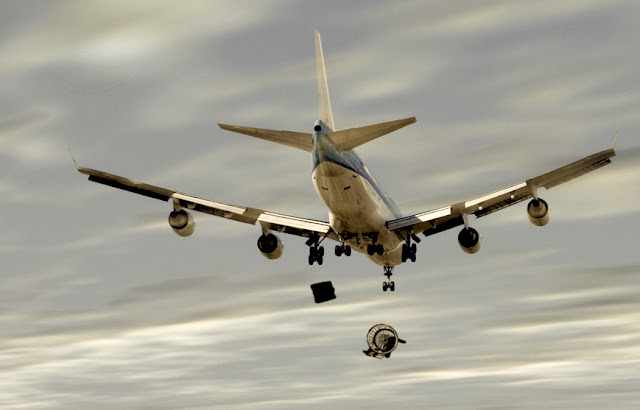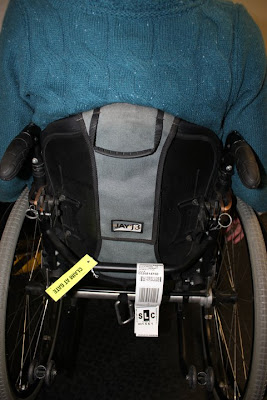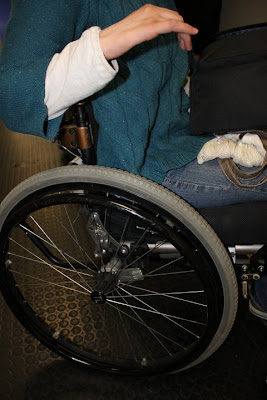In my 14 years of flying I've only had one bad incident, which took place last September. Delta Airlines dinged up my wheelchair (pictured above). Not bad, but bad enough to irritate. I'm not sure what happened from the time I left my chair, to the time it was returned to me, but someone did something. And it was a brand new, one-week-old, $2600 wheelchair... still had that new chair smell. Unfortunately I was in a hurry to get to my destination and ended up avoiding the whole complaint process. But this incident did get me thinking about how airlines handle our only source of mobility. In essence... our legs.
Now before I talk about what to do in the event an airlines damages your wheels, I have to stress that this type of damage doesn't happen every time someone with a wheelchair travels in an airplane, but... it does occasionally happen. That said, the likelihood of having your wheelchair (or other assistive device) damaged by an airline should NOT put you off flying or traveling. You should, however, educate yourself about airline practices and take the necessary precautions and actions.
Your Passenger Rights
If you have a disability and are flying on a U.S. airline, you have certain rights. The Air Carrier Access Act (ACAA) developed in 1986, lays out the rights guaranteed to all passengers with disabilities. United Spinal Association's Accessible Air Travel Guide is another great resource resource for air travel and disability and will answer many questions that you have about flying the friendly skies. Delta airlines even has a downloadable brochure entitled Traveling With Disabilities. It's just a good idea to familiarize yourself with these rights before traveling. For those interested in reading the official ACAA document, you can find it here (ACAA 14 CRF Part 382).
Wheelchair Stowage
Alright, let's finally get to the point of this post: stowage (or the latin term airlinus aggrivatae). There are two types of stowage: Onboard stowage and cargo compartment (checked luggage) stowage. The latter is the most common form of wheelchair stowage, although there are instances in which wheelchairs can be stowed on the aircraft.
- Onboard (Priority) Stowage: Every airline has policies and procedures pertaining to stowing your wheelchair on the aircraft. Here are the basic guidelines for most on-aircraft stowage:
- Must be a folding wheelchair
- One wheelchair per flight
- Stowage bin is on a first come, first serve basis
- Wheelchairs or other assistive devices take stowage bin priority over other luggage
- Must meet the size requirements for the stowage space - contact the airline in advance to see if your chair meets the size requirements.
When I was first paralyzed, I spoke to several people (also paralyzed) who told me I shouldn't fly unless the airline allowed me to store my chair in the plane's stowage space. In all my years of air travel, I've never stowed my chair in the main aircraft area. My chair has always been stowed below in the cargo stowage area. I've also never seen this "onboard" stowage compartment, although I know several aircrafts have one. Maybe it's right next to the refreshment cart or (possibly) the compartment where they keep the mythical airline unicornt. In any case, once you have your flight number, contact the airline to determine if your chair can fly with you. If it can (and if your chair meets the three quidelines) then request the space as soon as you can. Most airlines' websites have a brief description regarding onboard stowage and it's FIRST COME, FIRST SERVE. Here are few: Delta , American Airlines, Continental, U.S. Airways (could not find onboard stowage information), JetBlue. Southwest Airlines has a blank webpage regarding any accessibility info. For more information on priority stowage, see the ACAA Guidelines: 14 C.F.R. §382.123.
- Cargo Compartment (Luggage) Stowage: In the event that a wheelchair doesn't conform to the requirements of onboard stowage (i.e. Too much junk in the trunk), the chair must be stowed down below... just like Leonardo DiCaprio in "Titanic". Cargo stowage is the common scenario for individuals with non-folding (rigid frame) manual wheelchairs or power chairs. Here are some guidelines for cargo compartment stowage on most aircrafts:
- To be used when wheelchair measurements and type don't permit stowage onboard the aircraft
- To be used when onboard stowage space is occupied
- Must be given priority stowage over other baggage and cargo
- Applicable wheelchairs must be taken/returned as close to the aircraft door as possible
- Applicable wheelchairs must be the first items retrieved from the baggage compartment to ensure a prompt return to the passenger
- Applicable wheelchairs must be gate checked (with gate claim tag attached)
Power chairs must also be stowed underneath the plane. For more information on stowage for power chairs, see the ACAA Guidelines: 14 C.F.R. §382.127. Depending upon the type of chair and assistance needed (ex: airport personnel required for transport to aircraft) some folks will check their power chairs at main ticket counter, rather than gate checking their chairs. If you aren't inclined to check your chair as luggage and have airport staff wheel you to the plane, you can gate check your chair and leave it near the aircraft door for pickup. Again, most airlines' websites have a brief description regarding cargo compartment stowage. Here are few: Delta, American Airlines, Continental, U.S. Airways, JetBlue. For more information of general cargo stowage, see the ACAA Guidelines: 14 C.F.R. §382.125.
Stowage Issues
Now that you know your rights and how wheelchairs can be stowed during flight, it's time to talk about stowage issues. The most obvious issue is onboard (priority) stowage for rigid manual chairs and power chairs. Unless you have a folding chair, you aren't likely to store your wheelchair onboard the aircraft. I have a rigid frame chair, which doesn't fold. Therefore, I cannot store my plane in the priority stowage bin. I have no choice but to have my baby stowed in the cargo compartment. If you have a power chair, you definitely won't be able to stow your baby on board. The next big stowage issue, of course, relates to the safety of the merchandise. Will your wheelchair be stored properly and securely? In most instances... yes. But damage continues to occur, which means someone isn't doing their job. And let's face it: most baggage handlers don't realize how critical it is to maintain the integrity and functionality of a wheelchair because they don't use on themselves. To them, it's just another piece of luggage, and we've all seen baggage handlers toss suitcases around like juggling pins.
In 2006, the National Center for Accessible Transportation (Oregon State University) performed a study that addressed common wheelchair stowage issues in the hopes of finding solutions. The study was done in conjunction with several meetings with airline companies, wheelchair manufacturers and applicable governing agencies. Several issues were discussed, including:
- Wheelchair Issues: Some wheelchairs are easier to stow than others, due issues relating to chair size, shape and accessories.
- Aircraft Issues: Some cargo doors and stowage spaces aren't big enough to accommodate some wheelchairs.
- Loading Issues: In many instances, the elevators or conveyor belts used to load wheelchairs are incompatible or unavailable.
- Passenger Issues: Many passengers don't know their chairs (or the potential problems that could arise in handling/loading). Passengers also don't realize that others are unfamiliar with their chairs. YES! YOU NEED TO KNOW YOUR CHAIR SO THAT YOU CAN ALERT OTHERS TO POTENTIAL ISSUES (EX: PARTS THAT CAN FALL OFF)! Hip guards anyone?
- Communication Issues: Passengers and airport personnel aren't communicating. You have to be an advocate and let the airlines know your specific needs. Especially when it comes to handling your wheels. For example, if your chair doesn't collapse, you have to let airport staff know. Not everyone is as familiar with your chair as you are.
The consensus of the study was that further collaboration or regulation must take place to address the stowage issue by launching a plan that includes:
- Improvements in transportability of wheelchairs
- Better training and procedures for baggage handlers
- Better passenger input on special requirements for their chairs
- Agreement on the part of airlines to some standardization of procedures
While no "official" regulations or practices have been implemented, the airlines are at least aware of the issues involving wheelchair handling and stowage. Does this give you peace of mind? Maybe not. And that's why it's imperative that you do what you can to A) ensure that your chair is taken of and B) alert the responsible parties whenever your chair is damaged.
There's also the question of liability. Are the airlines responsible for damages? Yes, but in some instances you may have to prove that damages were caused by the airline. That's why taking a photo is a good idea. Some airlines may have you sign a liability waiver. DON'T DO IT! While some airlines do indeed have baggage liability limits, your wheelchair isn't baggage. And that's a very key differentiation between luggage and assistive devices. Different rules apply for assistive devices. Another key differentiation is fees. While many airlines charge for carry-on luggage, they cannot charge you extra for assistive devices. This includes both onboard and cargo compartment stowage. Simply put: airlines cannot charge you for checking your chair.
Preventive Measures
Knowing full well that once your chair leaves your sight, it's in fate's hands -- is there anything you can do to prevent damage during air travel? Yes and no. If some numnuts baggage handler or airport employee isn't careful (or up to speed on proper protocol for wheelchair stowage) then you (and your wheelchair) are S.O.L. That's trust being put to the ultimate test. So, what can you do to prevent damage to your chair?
- Make sure you remove any parts that may fall off during stowage. This includes anti-tip bars, seat cushions (I always sit on my cushion during the flight), hip guards. I usually place these items in my carry on bag.
- For chairs with batteries, make sure your battery is labelled "non-spillable" by the manufacturer. If your battery is spillable it may be removed by the airline and separately packaged/stowed... UNLESS it is securely attached to a chair that can be stowed UPRIGHT. If your battery leaks, you won't be able to stow it on the plane.
- Supply instructions for handling your wheelchair. This includes how to dismantle or fold the chair as well as the weight. Airlines are not expected to know how your chair operates, so I'd suggest giving them a written (or at the very least verbal) explanation of how to handle your wheels. Some people like to attach the instructions to the chair. Also, warn them if your chair is over 50 lbs. Remember, the heavier the chair, the harder to carry and the more likely it will or could be dropped.
- Take a photo of your chair before boarding your flight. I'd focus on the frame and wheel rims/spokes. This is ammo in case the airline contests the damage.
- Always bring your necessary wheelchair toolkit and tire repair supplies... just in case.
- Coordinate with airport personnel and those assisting you. Make sure the airline knows how important the chair is and how damage can severely affect your mobility. Communication is key!
- Know the size and weight of your chair. Better yet, research the aircraft and know the size of the stowage compartment requirements. Most airlines say they can handle all sizes, but it's good to know what size restrictions certain airlines may have. Contact your airline before your flight to confirm that your chair will fit in the aircraft's stowage area. You can also check the airline's website. Some carriers, like Delta, have their cargo dimensions listed online:
- Travel with an old wheelchair. I always bring my "travel chair" with me on my journeys because it can handle more aggressive handling and terrain. Most people will go through a few wheelchairs, depending on the severity of their disability. Don't throw away or give away old chairs, unless of course they're completely fubared. Always keep your old wheelchair for travel.
- Store your chair in a protective container. The company Haseltine Systems Incorporated makes two storage units for both folding and non-folding/motorized chairs. These containers, while good at protecting your wheels, are a bit of a burden in terms of additional travel gear. You may need to have the destination airport hold your container for the duration of your stay.
One of my friends always takes of photo (pictured above) of her wheelchair before boarding the plane. That way, if the baggage handler screws up and breaks her chair, she can show the before photo to the airline and get them to fix her chair. Not a bad idea. Bottom Line: If they broke it, they fix it or replace it. The airlines are responsible for the safety and integrity of your wheels. In the event that your chair ends up looking much different than it did before your departure, you should perform the following steps:
- STEP ONE: Inspect the chair for any damage and make notes
- STEP TWO: Contact the Complaints Resolution Officer/Official (CRO). CROs are located at all airports and/or can be contacted after-the-face. Ideally, it's best to talk to someone while the damage is still fresh. Don't give the airlines any reason plead innocent. In other words, don't continue with your vacation, run the risk of additional damage and then contact the airlines.
- STEP THREE: Fill out a written statement (usually provided by the CRO) regarding equipment damage. This statement should be provided at the airport or sent to the passenger within 10 days of the complaint.
- STEP FOUR: If no statement is provided, and/or the airline in uncooperative, file a complaint with the U.S. Department of Transportation (DOT).
U.S. Department of Transportation
Aviation Consumer Protection Division, C-25
400 7th Street, SW
Washington, DC 20590
(202) 366-2220
(202) 366-0511 (TTY)
airconsumer@ost.dot.gov
The airlines should respond quickly and appropriately to your needs. If you are traveling on a foreign air carrier, you should still meet with that airline's CRO to resolve any issues. Again, prevention is the best course of action. So make sure that all removable accessories are secure before handing over your wheels to the airline/airport personnel.
In some instances, the airlines will perform an inspection of your chair, before and after the flight. Below is a photo from my friend's chair during a flight on Southwest Airlines. Southwest does a visual inspection of the chair before it is taken into custody (for the duration of the flight). It's always a good idea to make sure that your airline performs this inspection. Like Otis Redding once said: "I want Se-Cur-i-Teee, Yeeaaahhh".
Creative Stowage
Okay, I just added this one because I've had experiences traveling in very small planes. Puddle-jumpers that have no stowage compartments for wheelchairs. Tropic Air, for example, is a small airline that transports passengers from mainland Belize to the nearby island of Amergris Caye. While traveling on Tropic Air's flying bus, I was able to (for the first time in my entire air travel history) stow my chair on the plane. Actually, I disassembled my chair and placed on the floor in front of me. No straps or stowage bins. Just a pile of wheels and a frame on top. Safe? Probably not. Adventurous? You damn right. I'm sure this breaks some type of aviation regulation, but when traveling abroad... sometimes you gotta think outside the stowage bin.
 |
| Preparing to board Tropic Air |
 |
| Tropic Air Onboard Wheelchair Stowage |
So there you have it. Wheelchair stowage. Most likely, a lot to take in... especially for one blog post. But I think it's an issue that prevents many from flying. Airlines and government agencies are getting better about addressing the stowage issue, but there's still a lot that needs to be done. And that's where you, the now newly educated about wheelchair stowage traveler can help: If an airline damages your wheels, take appropriate action. Being silent (like I was... yeah, yeah I know "roll the roll" Stan) doesn't help anyone, including the airline industry. Make waves for change. Finally, when traveling abroad, just remember that it's always important to maintain the functionality of your assistive devices. Better to have a well-oiled machine that works to your advantage than gear that renders you immobile. Us wheelies don't get far on foot, so it's important to do proper research and take the necessary precautions so that you can fully enjoy your many adventures.












